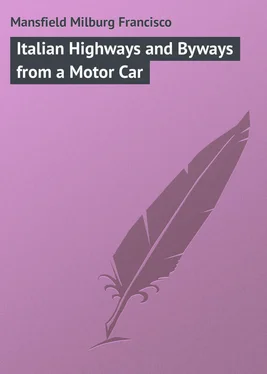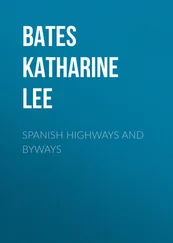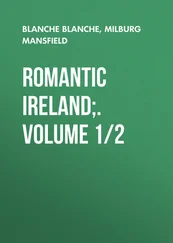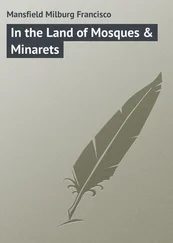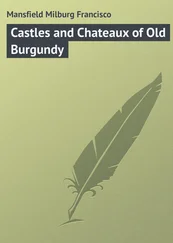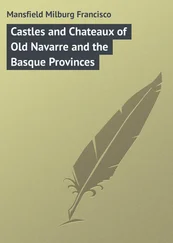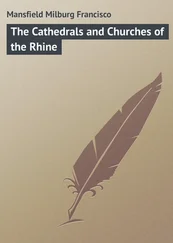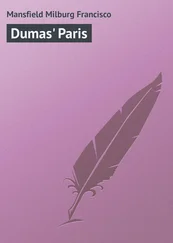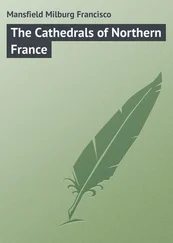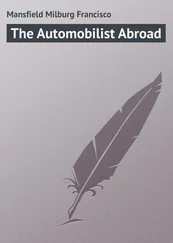Milburg Mansfield - Italian Highways and Byways from a Motor Car
Здесь есть возможность читать онлайн «Milburg Mansfield - Italian Highways and Byways from a Motor Car» — ознакомительный отрывок электронной книги совершенно бесплатно, а после прочтения отрывка купить полную версию. В некоторых случаях можно слушать аудио, скачать через торрент в формате fb2 и присутствует краткое содержание. Жанр: foreign_prose, Путешествия и география, на английском языке. Описание произведения, (предисловие) а так же отзывы посетителей доступны на портале библиотеки ЛибКат.
- Название:Italian Highways and Byways from a Motor Car
- Автор:
- Жанр:
- Год:неизвестен
- ISBN:нет данных
- Рейтинг книги:3 / 5. Голосов: 1
-
Избранное:Добавить в избранное
- Отзывы:
-
Ваша оценка:
- 60
- 1
- 2
- 3
- 4
- 5
Italian Highways and Byways from a Motor Car: краткое содержание, описание и аннотация
Предлагаем к чтению аннотацию, описание, краткое содержание или предисловие (зависит от того, что написал сам автор книги «Italian Highways and Byways from a Motor Car»). Если вы не нашли необходимую информацию о книге — напишите в комментариях, мы постараемся отыскать её.
Italian Highways and Byways from a Motor Car — читать онлайн ознакомительный отрывок
Ниже представлен текст книги, разбитый по страницам. Система сохранения места последней прочитанной страницы, позволяет с удобством читать онлайн бесплатно книгу «Italian Highways and Byways from a Motor Car», без необходимости каждый раз заново искать на чём Вы остановились. Поставьте закладку, и сможете в любой момент перейти на страницу, на которой закончили чтение.
Интервал:
Закладка:
Francis Miltoun
Italian Highways and Byways from a Motor Car
CHAPTER I
THE WAY ABOUT ITALY
ONE travels in Italy chiefly in search of the picturesque, but in Florence, Rome, Naples, Venice or Milan, and in the larger towns lying between, there is, in spite of the romantic association of great names, little that appeals to one in a personal sense. One admires what Ruskin, Hare or Symonds tells one to admire, gets a smattering of the romantic history of the great families of the palaces and villas of Rome and Florence, but absorbs little or nothing of the genuine feudal traditions of the background regions away from the well-worn roads.
Along the highways and byways runs the itinerary of the author and illustrator of this book, and they have thus been able to view many of the beauties and charms of the countryside which have been unknown to most travellers in Italy in these days of the modern railway.
Alla Campagna was our watchword as we set out to pass as many of our Italian days and nights as possible in places little celebrated in popular annals, a better way of knowing Italy than one will ever know it when viewed simply from the Vatican steps or Frascati’s gardens.
The palaces and villas of Rome, Florence and Venice are known to most European travellers – as they know Capri, Vesuvius or Amalfi; but of the grim castles of Ancona, of Rimini and Ravenna, and of the classic charms of Taormina or of Sarazza they know considerably less; and still less of Monte Cristo’s Island, of Elba, of Otranto, and of the little hidden-away mountain towns of the Alps of Piedmont and the Val d’Aoste.
The automobile, as a means of getting about, has opened up many old and half-used byways, and the automobile traveller of to-day may confidently assert that he has come to know the countryside of a beloved land as it was not even possible for his grandfathers to know it.
The Italian tour may be made as a conducted tour, as an educative tour, as a mere butterfly tour (as it often has been), or as a honeymoon trip, but the reason for its making is always the same; the fact that Italy is a soft, fair, romantic land where many things have existed, and still exist, that may be found nowhere else on earth.
The romance of travel and the process of gathering legends and tales of local manners and customs is in no way spoiled because of modern means of travel. Many a hitherto unexploited locality, with as worthy a monumental shrine as many more celebrated, will now become accessible, perhaps even well known.
The pilgrim goes to Italy because of his devotion to religion, or to art or architecture, and, since this is the reason for his going, it is this reason, too, which has caused the making of more travel books on Italy than on all other continental countries combined. There are some who affect only “old masters” or literary shrines, others who crave palaces or villas, and yet others who haunt the roulette tables of Monte Carlo, Biarritz, or some exclusive Club in the “Eternal City.” European travel is all things to all men.
The pilgrims that come to Italy in increasing numbers each year are not all born and bred of artistic tastes, but the expedition soon brings a glimmer of it to the most sordid soul that ever took his amusements apart from his edification, and therein lies the secret of pleasurable travel for all classes. The automobilist should bear this in mind and not eat up the roadway through Æmilia at sixty miles an hour simply because it is possible. There are things to see en route, though none of your speeding friends have ever mentioned them. Get acquainted with them yourself and pass the information on to the next. That is what the automobile is doing for modern travel – more than the stage or the railway ever did, and more than the aeroplane ever will!
One does not forget the American who went home to the “Far West” and recalled Rome as the city where he bought an alleged panama hat (made probably at Leghorn). He is no myth. One sees his like every day. He who hurried his daughter away from the dim outlined aisles of Milan’s Gothic wonder to see the new electric light works and the model tramway station was one of these, but he was the better for having done a round of the cathedrals of Italy, even if he did get a hazy idea of them mixed up with his practical observations on street-lighting and transportation.
Superficial Italian itineraries have been made often, and their chronicles set down. They are still being made, and chronicled, but the makers of guide books have, as yet, catered but little to the class of leisurely travellers, a class who would like to know where some of these unexploited monuments exist; where these unfamiliar histories and legends may be heard, and how they may all be arrived at, absorbed and digested. The people of the countryside, too, are usually more interesting than those of the towns. One has only to compare the Italian peasant and his picturesque life with the top-hatted and frock-coated Roman of to-day to arrive quickly to a conclusion as to which is typical of his surroundings. The Medicis, the Borgias, and the Colonnas have gone, and to find the real romantic Italian and his manner of life one has to hunt him in the small towns.
The modern traveller in Italy by road will do well to recall the conditions which met the traveller of past days. The mere recollection of a few names and dates will enable the automobilist to classify his impressions on the road in a more definite and satisfying manner than if he took no cognizance of the pilgrims who have gone before.
Chaucer set out ostensibly for Genoa in 1373 and incidentally met Petrarch at Padua and talked shop. A monk named Felix, from Ulm on the banks of the Danube, en route for Jerusalem, stopped off at Venice and wrote things down about it in his diary, which he called a “faithful description.” Albrecht Durer visited Venice in 1505 and made friends with many there, and from Venice went to Bologna and Ferrara. An English crusading knight in the same century “took in” Italy en route to the Holy Land, entering the country via Chambéry and Aiguebelle – the most delightful gateway even to-day. Automobilists should work this itinerary out on some diagrammatic road map. Martin Luther, “with some business to transact with the Pope’s Vicar,” passed through Milan, Pavia, Bologna and Florence on his way to Rome, and Rabelais in 1532 followed in the train of Cardinal du Bellay, and his account of how he “saw the Pope” is interesting reading in these days when even personally-conducted tourists look forward to the same thing. Joachim du Bellay’s “visions of Rome” are good poetry, but as he was partisan to his own beloved Loire gaulois , to the disparagement of the Tiber latin , their topographical worth is somewhat discounted.
Sir Philip Sidney was in Padua and Venice in 1573, and he brought back a portrait of himself painted in the latter city by Paul Veronese, as tourists to-day carry away wine glasses with their initials embossed on them. The sentiment is the same, but taste was better in the old days.
Rubens was at Venice in 1600, and there are those who say that Shakespeare got his local colour “on the spot.” Mr. Sidney Lee says no!
Back to the land, as Dante, Petrarch, even Horace and Virgil, have said. Dante the wayfarer was a mighty traveller, and so was Petrach. Horace and Virgil took their viewpoints from the Roman capital, but they penned faithful pictures which in setting and colouring have, in but few instances, changed unto this day.
Dante is believed to have been in Rome when the first sentence was passed upon him, and from the Eternal City one can follow his journeyings northward by easy stages to Siena and Arezzo, to the Alps, to Padua, on the Aemilian Way, his wandering on Roman roads, his flight by sea to Marseilles, again at Verona and finally at Ravenna, the last refuge.
Читать дальшеИнтервал:
Закладка:
Похожие книги на «Italian Highways and Byways from a Motor Car»
Представляем Вашему вниманию похожие книги на «Italian Highways and Byways from a Motor Car» списком для выбора. Мы отобрали схожую по названию и смыслу литературу в надежде предоставить читателям больше вариантов отыскать новые, интересные, ещё непрочитанные произведения.
Обсуждение, отзывы о книге «Italian Highways and Byways from a Motor Car» и просто собственные мнения читателей. Оставьте ваши комментарии, напишите, что Вы думаете о произведении, его смысле или главных героях. Укажите что конкретно понравилось, а что нет, и почему Вы так считаете.
